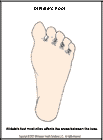
Athlete's Foot
What is athlete's foot?
Athlete's foot is a common skin problem caused by a fungus. Usually beginning on the skin between the toes, the fungus infection becomes scaly and itchy. Over time it may cause a break in the skin and become sore. Another term for athlete's foot is tinea pedis.
How does it occur?
The fungus that causes athlete's foot is everywhere in the environment. It is commonly picked up from the floors of showers, locker rooms, and exercise facilities. The fungus is more likely to grow on sweaty, constantly wet, or improperly dried feet (especially in shoes or socks with poor ventilation).
What are the symptoms?
Symptoms on the feet include:
- itching
- cracked and peeling skin, usually between the last two toes
- soreness
- blisters (occasionally).
How is it diagnosed?
Your health care provider can usually diagnose athlete's foot after examining your skin. Sometimes he or she may swab or scrape off a skin sample to test for fungus. If your provider suspects that you may also have a bacterial infection, the skin sample may be tested for bacteria.
How is it treated?
Athlete's foot can often be treated successfully with a nonprescription antifungal medicine such as Micatin, Tinactin, or Desenex. These medicines are creams that you put on the skin of your foot. If the infection is severe or widespread, your health care provider may prescribe a medicine to take by mouth.
How long will the effects last?
Some people have mild athlete's foot infections just once in a while. These infections usually clear up in a few days. Other people have infections often or nearly constantly for weeks, months, or years. If you have frequent or prolonged problems, see your health care provider. Your health care provider may prescribe medicine that not only treats the ongoing itch and discomfort but also helps prevent a more serious bacterial infection.
How can I help prevent athlete's foot?
Follow these guidelines:
- Keep your feet clean and dry, especially in hot weather. Dry your feet well after bathing, especially between the toes.
- Put an antifungal powder on the infected areas of your feet.
- Wear cotton or wool socks.
- Change your socks every day, or more often if the socks become damp.
- Wear sandals or shoes with ventilation holes or porous upper material (a natural material such as canvas or leather rather than man-made material).
- Air out your shoes when you aren't wearing them.
- Wear thongs or sandals when you take a shower in a locker room.
- Disinfect shower and locker room floors.

